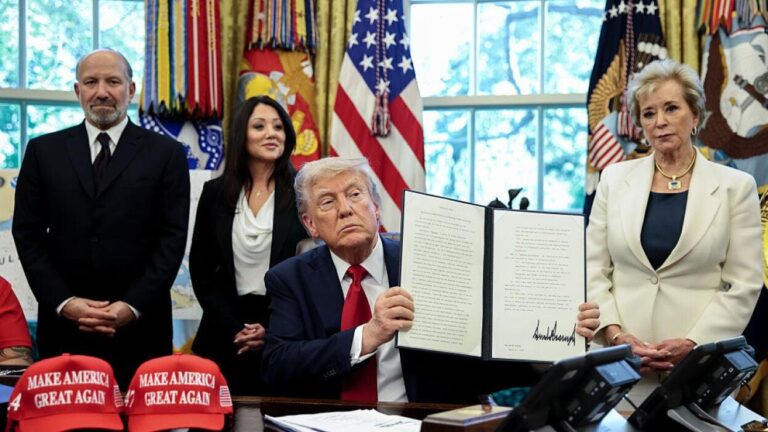In a move aimed at strengthening the United States’ position in the rapidly evolving field of artificial intelligence, President Donald Trump has signed an executive order focused on expanding AI integration in K-12 education. The directive seeks to enhance resources, training, and infrastructure to prepare students for a future increasingly shaped by technology. The administration’s initiative underscores a growing emphasis on equipping younger generations with the skills necessary to compete in a global digital economy.
President Trump Advances AI Integration in K-12 Education Through New Executive Order
The executive order signed by President Trump marks a pivotal step toward modernizing the educational landscape nationwide. By prioritizing the integration of artificial intelligence tools in K-12 curricula, the administration aims to enhance personalized learning experiences, streamline administrative tasks for educators, and prepare students for a rapidly evolving digital economy. Among the initiatives highlighted are pilot programs in over 500 public schools, increased funding for AI-driven educational software, and partnerships with leading tech companies to ensure equitable access in underserved communities.
Key components of the order include:
- Implementation of AI-powered tutoring systems tailored to individual student needs
- Teacher training programs focused on leveraging AI for classroom management and lesson planning
- Creation of a national AI education task force to monitor progress and recommend future policies
| Program | Goal | Funding |
|---|---|---|
| AI Tutoring Pilot | Personalized instruction | $50M |
| Teacher AI Workshops | Professional development | $20M |
| Tech Equity Grants | Cross-region access | $30M |
Enhanced Funding and Resources to Support AI Curriculum Development in Schools
In a decisive move to further American leadership in artificial intelligence education, the administration has committed to significantly expanding financial support for curriculum innovation in K-12 schools. This initiative allocates millions of dollars to enable schools to procure state-of-the-art AI teaching tools, hire specialized educators, and develop comprehensive training modules tailored to diverse learning environments. These funds are expected to foster partnerships between public schools, private tech companies, and universities, creating a thriving ecosystem for AI literacy at the foundational educational level.
Key elements of the funding and resources package include:
- Grants for AI curriculum development tailored for elementary through high schools
- Subsidies for teacher certification programs focused on AI and machine learning
- Provision of AI-enabled hardware and software in under-resourced schools
- Funding for after-school AI clubs and competitions to encourage practical engagement
| Funding Area | Allocated Amount | Target Beneficiaries |
|---|---|---|
| Curriculum Innovation Grants | $200 million | School districts nationwide |
| Teacher Training Programs | $75 million | Educators and administrators |
| AI Hardware & Software | $125 million | Low-income schools |
Teacher Training and Infrastructure Upgrades Central to Executive Order Implementation
The executive order signed by President Trump places a significant emphasis on enhancing teacher training programs to ensure educators are well-equipped to integrate AI technologies into their classrooms effectively. With a focus on continuous professional development, the initiative mandates nationwide workshops, certification courses, and access to cutting-edge AI tools, enabling teachers to gain hands-on experience. This approach aims to bridge the knowledge gap and foster confidence in using AI-powered teaching aids to improve student outcomes.
Simultaneously, substantial investments have been allocated toward upgrading school infrastructure to accommodate the latest AI systems. This includes modernizing computer labs, expanding high-speed internet access, and installing AI-driven learning platforms across districts. The executive order advocates for collaboration between federal agencies and local school boards to ensure these upgrades are both widespread and sustainable.
- Teacher Training: Interactive AI workshops and certification
- Infrastructure: High-speed internet and smart classroom technology
- Funding Source: Federal grants and public-private partnerships
| Component | Details | Timeline |
|---|---|---|
| Teacher Training | AI curriculum integration certification | 2024 ‚Äď 2025 |
| Infrastructure Upgrade | Smart devices and high-speed connectivity | 2024 ‚Äď 2026 |
| Funding Allocation | Grant disbursements to schools | 2024 Q3 onwards |
Experts Call for Balanced Approach to AI Use in Classrooms Emphasizing Ethics and Equity
Amidst the recent executive order promoting the integration of artificial intelligence in K-12 education, specialists emphasize a cautious yet proactive strategy to harness AI’s potential responsibly. Key voices in the education sector urge that AI adoption must go hand-in-hand with a rigorous ethical framework. This includes prioritizing student data privacy, preventing bias in AI algorithms, and ensuring transparency in how AI tools influence learning outcomes. Experts highlight the importance of inclusive development, ensuring AI technologies do not inadvertently widen existing inequalities among diverse student populations.
To address these critical concerns, educators and policymakers are recommending a set of best practices designed to create a fair and ethical AI landscape in schools. These include:
- Ongoing training for teachers to effectively integrate AI while understanding its limitations.
- Equity audits to monitor AI’s impact on different student demographics.
- Collaborative policy-making involving ethicists, technologists, and community representatives.
- Student-centered AI design that reflects diverse learning needs and cultural backgrounds.
| Focus Area | Action Item | Expected Outcome |
|---|---|---|
| Ethical AI Use | Develop clear guidelines | Protect student rights |
| Equity | Conduct regular equity audits | Reduce achievement gaps |
| Teacher Support | Provide AI training programs | Increase effective use |
| Transparency | Require explainable AI | Build trust among users |
Future Outlook
As President Trump signs the executive order aimed at expanding artificial intelligence resources in K-12 education, the move marks a significant federal push to integrate advanced technology into classrooms nationwide. Advocates say the initiative could better prepare students for the evolving job market, while critics urge careful consideration of ethical implications and equitable access. As schools begin to implement these new directives, educators and policymakers alike will be closely monitoring the impact on teaching and learning in the years ahead.




